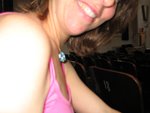How to Watch a Dance/Technology Performance
As a company member of Troika Ranch, I have had experience with technology from a performer's point of view. The ground rule is that in the "battle" between technology and dancers--humans win. Don't stop dancing if the technology fails in some way. We spent a lot of time developing ideas, movement vocabulary, and technology elements. Everything worked together to create an atmosphere, tell a story, or convey a mood. In the end, a performance would fuse technology with dance in a seamless manner, although it was often a complex number of elements that came together to make the piece.
When I went to my first Troika Ranch performance as an audience member, I knew that the dancers were manipulating elements such as video and sound live during the show. It's easy to get caught up in asking yourself, "How are they doing that?" I realized in a matter of moments that the best tactic was to sit back, relax, and take it all in. Analyzing can come later. So this led me to some rules about how an audience member should view a dance performance, specifically one that utilizes technology.
When I went to my first Troika Ranch performance as an audience member, I knew that the dancers were manipulating elements such as video and sound live during the show. It's easy to get caught up in asking yourself, "How are they doing that?" I realized in a matter of moments that the best tactic was to sit back, relax, and take it all in. Analyzing can come later. So this led me to some rules about how an audience member should view a dance performance, specifically one that utilizes technology.
- Read the program notes before and/or after the show.
- Read about the technology before and/or after the show.
- Save analyzing for after the show. Ask questions and talk to the performers and the creators.
- Let the performance wash over you, just absorb what is being shown. Allow yourself to have emotional and visceral responses to what you see.
- See the work again.
- Learn about technology available to artists.
Just as when you attend a music performance you don't get immediately involved in thinking about the amplifiers and busy yourself with how the instruments make a certain sound, the same should be true in the dance audience. Just as when you go to a museum, you look, appreciate, and react to what you see. You don't start out by analyzing brush strokes, media, composition--you just allow yourself to witness what is before you, and then you can analyze it later if you want.
You can educate yourself before and/or after a dance/technology performance, but it's not as important to know the technology and technique, as it is to experience the work at hand. I encourage audiences to see the same works of dance multiple times to become more familiar with the work and be able to see details and connections you may have missed the first time. In music it is acceptable and desired to see groups or hear songs multiple times. In visual art it is acceptable to view the same work multiple times. Why do dance audiences seem to demand something new at every performance? "I saw that dance already." Is it no good anymore? "I've already heard Beethoven." "I already saw Monet's "Waterlilies."
You can educate yourself before and/or after a dance/technology performance, but it's not as important to know the technology and technique, as it is to experience the work at hand. I encourage audiences to see the same works of dance multiple times to become more familiar with the work and be able to see details and connections you may have missed the first time. In music it is acceptable and desired to see groups or hear songs multiple times. In visual art it is acceptable to view the same work multiple times. Why do dance audiences seem to demand something new at every performance? "I saw that dance already." Is it no good anymore? "I've already heard Beethoven." "I already saw Monet's "Waterlilies."



0 Comments:
Post a Comment
<< Home